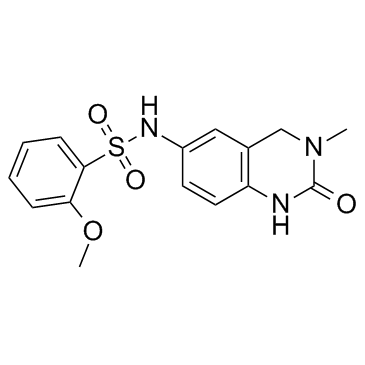| Description |
PFI-1 is a selective BET (bromodomain-containing protein) inhibitor for BRD4 with IC50 of 0.22 μM in a cell-free assay.
|
| Related Catalog |
|
| Target |
IC50: 0.22 μM (BRD4)
|
| In Vitro |
PFI-1 has antiproliferative effects on leukemic cell lines and efficiently abrogates their clonogenic growth. Exposure of sensitive cell lines with PFI-1 results in G1 cell-cycle arrest, downregulation of MYC expression, as well as induction of apoptosis and induces differentiation of primary leukemic blasts. Cells exposed to PFI-1 show significant downregulation of Aurora B kinase, thus attenuating phosphorylation of the Aurora substrate H3S10, providing an alternative strategy for the specific inhibition of this well-established oncology target[1]. PFI-1 binds to with cyclic AMP response binding protein with Kd of 49 μM. PFI-1 has an EC50 of 1.89 μM for the inhibition of IL6 production from human blood mononuclear cells stimulated by LPS[2]. PFI-1 induces dose-dependent reduction of cell viability in T4302 CD133+ cells[3]. PFI-1 inhibits the proliferating of three NET cell lines (Bon-1 derived from a pancreatic NET, and H727 and H720 derived from lung NETs)[4].
|
| In Vivo |
PFI-1 administrated (1 mg/kg, i.v.) in the rat results in the volume of distribution of 1 L/kg, the plasma clearance of 18 mL/min/kg and half-life of 1 hour. PFI-1 oral dosed (2 mg/kg) in the rat results in the oral bioavailability as low as 32%. PFI-1 administrated (2 mg/kg, s.c.) in the mouse results in a Cmax of 58 ng/mL with a Tmax of 1 h and a half-life of approximately 2 hours[2].
|
| References |
[1]. Picaud S, et al. PFI-1, a Highly Selective Protein Interaction Inhibitor, Targeting BET Bromodomains. Cancer Res. 2013 May 21. [Epub ahead of print] [2]. Fish PV, et al. Identification of a chemical probe for bromo and extra C-terminal bromodomain inhibition through optimization of a fragment-derived hit. J Med Chem. 2012 Nov 26;55(22):9831-7. [3]. Cheng Z, et al. Inhibition of BET bromodomain targets genetically diverse glioblastoma. Clin Cancer Res. 2013 Apr 1;19(7):1748-59. [4]. Kate E Lines, et al. Epigenetic modifiers reduce proliferation of human neuroendocrine tumour cell lines. Endocrine Abstracts (2013) 31 P149
|
